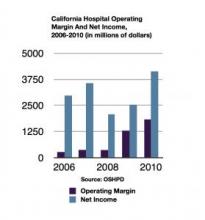Healthier Finances For State’s Hospitals

The period of financial austerity California's hospitals experienced during the Great Recession appears to be lifting, although many facilities still struggle to operate with positive profit margins.
That's the findings of a new report by the Office of Statewide Health Planning and Development, which collects and crunches data on California's 400-plus acute care facilities.
Aggregate hospital operating income which was consistently below $400 million even in 2006, a year before the Great Recession descended, has rebounded dramatically. It reached $1.8 billion in 2010. And while the total margin was in negative territory as recently as the third quarter of 2011, it rose to 7.2% by the first quarter of 2012.
Overall net income had also plunged with the stock market: In 2008, it was $2.1 billion, a 40% drop from 2007. But by 2010, it topped $4.1 billion.
Steven T. Valentine, president of The Camden Group, an El Segundo-based consulting firm that focuses on hospitals and a member of the Payers & Providers editorial board, noted that many hospitals moved to trim their workforces as the recession began to take hold in late 2007 and early 2008.
“When you reach the depth of people being unemployed and uninsured in 2009 and 2010, the margins really went up, and you can attribute that to decreased expenses.”
The cutting of jobs appeared to be among lower tier maintenance workers and technicians, while more heavily unionized – and better compensated – nurses remained on the payroll. Partly as a result, labor costs rose 29.5% between 2006 and 2010. Per full-time employee, they rose from $77,021 to $95,222.
And Valentine added that the overall operating margins for hospitals – 3.4% in late 2011 and 2% in early 2012, are still anemic. “It is typical for an industry that is highly capitalized,” he said, noting the huge infrastructure costs involved in building and running hospitals.
Jan Emerson-Shea, vice president of external communications for the California Hospital Association, noted that the Medi-Cal provider fee has also played a role in the stabilizing of hospitals’ bottom lines in recent years. The fee has brought in about $2 billion a year since 2009, although hospitals also have to pay into the program to leverage the additional funds.
“Without the fee, hospitals would be losing more than $5 billion annually in Medi-Cal payment shortfalls. Even with the fee, hospitals are losing $2.5 billion a year in Medi-Cal payments,” she said.
But Emerson-Shea observed that hospitals in the California still have a tough time ahead. “More recently, commercial rates have tightened and hospital margins have leveled off,” she said.






